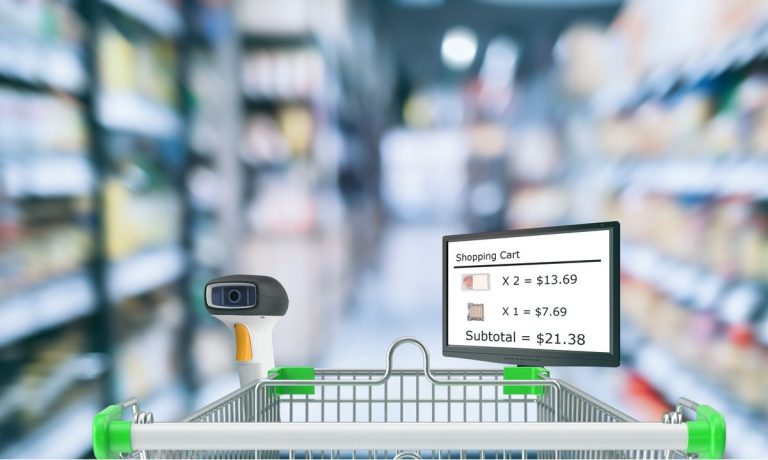
The benefits for the consumer of using smart carts are obvious — by offering cashier-free checkout, they remove one of the main pain points of grocery shopping. From Amazon’s Dash Carts at the mega-retailer’s grocery stores and Kroger’s KroGo carts to the Foodstuffs chain’s SmartCarts in New Zealand and the Sobeys Smart Cart in Canada, retailers have been taking the opportunity over the last couple years to provide their shoppers with this frictionless option. It is not only the shopper, however, who benefits from using these carts — the grocer also benefits from the marketing and data-retrieving opportunities that these digitized carts provide.
“Continuous communication throughout the shopping journey is becoming possible,” Raz Golan, CEO and co-founder of grocery store technology company Shopic, told PYMNTS in a recent interview. “Up until today, there was this black hole. Retailers weren’t successful in communicating with their customers as they shopped in their physical stores, and most of the time, they didn’t know that they were even in the store until the time of payment. So the fact that can … continuously talk to them … is something new.”
Shopic creates a device that allows grocers to retrofit their existing shopping carts with smart technology powered by artificial intelligence (AI) to eliminate checkout, display promotional messaging and learn about consumers’ behavior as they move through the store. Earlier this summer, the company announced a $10 million funding round, bringing its total funding to $21 million.
Read more: SmartCart Rolls Into New Zealand Grocery Store
Kroger Joins Amazon In The Race To Add ‘Smart’ Grocery Carts
Amazon Introduces Smart Shopping Carts At LA Supermarket
Retail Pulse: Sobeys Tests Intelligent Shopping Cart; Amazon Expands Counter Service
Smarter Carts = Smarter Aisles
“Our clip-on device is capable of collecting very valuable analytics on the store environment, on the shelves on how and where shoppers go around the store,” said Golan. “We help [retailers] to improve their operations…and also improve their communication with their customer by better understanding their shopping habits.”
By tracking consumers’ behavior, smart carts can give information about which areas of the store are frequently visited by shoppers and which are being overlooked. They can look at the order in which consumers are picking up items and note the items that are being picked up but then placed back on stores. With these data, grocers can rethink their store layout informed by insights that go beyond the decades-old conventional wisdom on which many grocers continue to base their decisions.
In addition to noting consumers’ buying behavior, smart carts can also prompt buying behavior, both in ways that the consumer opts in to and through suggestive messaging.
Regarding the former, Golan noted that smart carts can provide the opportunity for shoppers to create interactive shopping lists before entering to the store. “Then our system builds you the optimal route around the store and directs you to where you need to go.”
Carts can also offer deals and other promotional messaging informed by data such as the shopper’s previous purchases and based on which items they are near in the store.
“This is what the next generation of the in-store journey should look like,” Golan said. “All these data points are ones that we just couldn’t measure very well until today, and it opens a whole new world of data analytics.”
Lowering Barriers For Retailers And Consumers
By allowing retailers to just retrofitting their existing carts, rather than requiring them to deck out their whole store in cameras and sensors, Shopic makes it possible for smaller businesses to implement smart carts.
“What’s most important for us is understanding that retailers are operational businesses,” said Golan. “Those very low net margins are what drive the decision-making of the business. I think not only taking in mind that technology, but not its operational impact, is something that we don’t see enough.”
He added that the technology has proven, contrary to the company’s initial predictions, to be accessible for consumers across demographic lines. While initial hypotheses posited that younger millennials would be the first to adopt this technology, data from Shopic’s deployments so far show that “even people who are over 50, 60 and 70 years old have chosen to try the new shopping experience,” and that they continue to take advantage of the technology on subsequent trips.
The Frictionless Future Of The Grocery Store
There are benefits that in-store shopping has over online grocery purchasing, offering opportunities to discover new products, and allowing shoppers to look at and touch high-consideration items. For instance, data from PYMNTS Omnichannel Grocery Report, created in collaboration with ACI Worldwide, finds that more than 80 percent of shoppers buy fresh fruits and vegetables and fresh meat in physical stores. Golan predicts that smart technology will allow the in-store shopping experience to retain these benefits while integrating the convenience of the ecommerce experience.
See also: NEW DATA: What US Consumers Want Grocery Stores To Know About How They Want To Shop And Pay
“We think that the distance between ecommerce and physical store experience is becoming smaller,” he said. “The way that you shop online — you’ll be able to experience this in physical stores as well, and that’s what we are aiming for.”
He added that, as the brick-and-mortar journey becomes easier and more seamless, other factors that tend to discourage would-be shoppers from making the trip to the store will no longer be of concern, bringing joy into the shopping experience.
“You will be able to go to the store at any time or any day, regardless of if it’s a weekend or a holiday,” he said. “And it will turn from a chore into a much more fun and easy-to-do experience.”